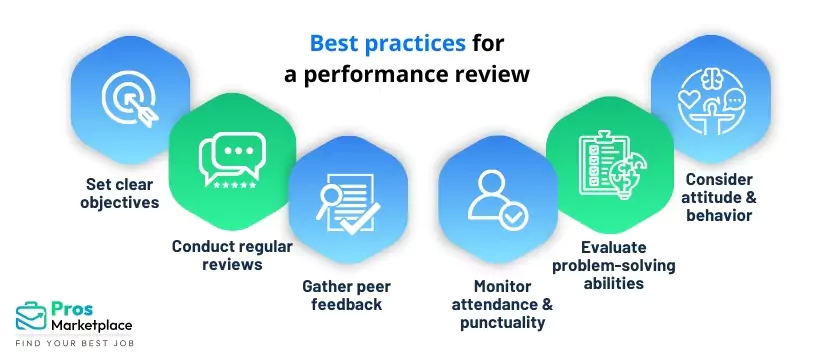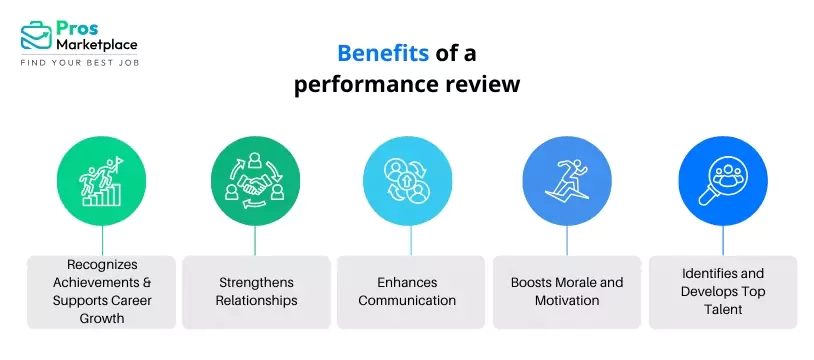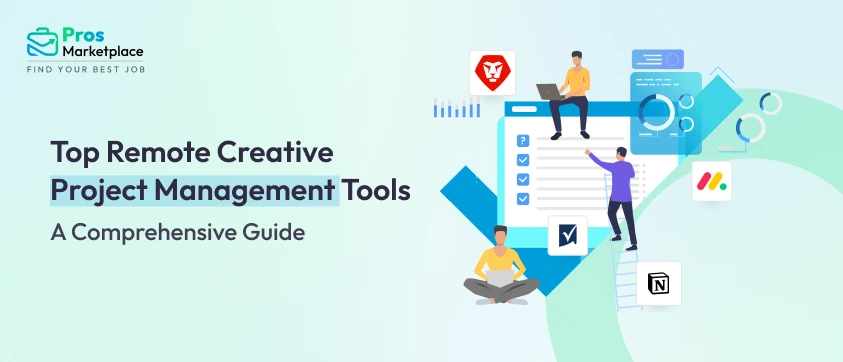Evaluating employee performance is a must for the long-term success of any business. It’s about understanding how well employees are fulfilling their responsibilities and achieving their goals. By doing this, managers can provide positive feedback and encourage performance improvement. This keeps employees engaged and motivated. It includes qualities such as a good work ethic, meeting deadlines, creativity, and problem-solving skills.
Regular evaluations and processes support a culture of continuous improvement. They create an open space for communication between employees and managers. This helps align expectations with the company’s vision. These steps range from setting clear goals to thinking about behavior and attitudes. Each step provides detailed information about the fundraiser. Following these steps can help organizations create effective management systems. The system increases productivity, increases job satisfaction, and promotes long-term success.
They provide opportunities to recognize achievements and stimulate growth. Companies can maximize their employees’ performance by focusing on clear, measurable standards and conducting regular reviews. This process benefits the individual and the organization, thus increasing the productivity of employees.
What do you do before a performance review?
Performance reviews don’t happen overnight. They need to be carefully planned and thought out. Before conducting an in-depth analysis, managers need to establish a solid foundation. Employees must understand what is being done in their role. Performance reviews are important. They usually relate to wages and employment. Therefore, they deserve your time and attention. A slow review can leave employees feeling undervalued and confused. Managers should allow sufficient time for these discussions and pay close attention to employee behavior in the months leading up to the review.
This allows for a more comprehensive and accurate assessment of performance and its impact on the organization. Are employees stuck because of a lack of skills, motivation, or talent that does not fit the role? Each situation requires a different approach. Perhaps training goals can address a skill deficiency, while increased motivation or independence can increase motivation. In some cases, a change in responsibility or even termination may be necessary. These people are assets to the organization. Identifying their strengths, rewarding them appropriately, and creating opportunities for growth can help you retain them and inspire others. Making good decisions about employee performance is difficult, but necessary. By following these steps, managers can create a more efficient and fair review process.
Best practices for a performance review

Set clear objectives
Having clear objectives for employees is essential. The goals you set should be specific, measurable, achievable, relevant, and time-bound (SMART). Clear objectives guide employees, showing what is expected. This alignment helps focus efforts on the company’s goals. When objectives are clear, measuring performance against them becomes straightforward. Well-defined goals also motivate employees to excel. Regularly reviewing these objectives ensures they stay relevant and attainable. This practice keeps everyone on track and is the first step in effective performance measurement, as it lays a strong foundation for success.
Conduct regular reviews
Regular performance reviews are essential for tracking employee progress, as they offer a chance for managers and employees. In them, you can discuss accomplishments and areas needing improvement. The reviews should be scheduled periodically, such as quarterly or annually. Structured reviews provide constructive feedback. They help identify training needs and career development opportunities. Regular reviews encourage open communication between employees and managers. This practice is crucial for ongoing performance improvement. It helps maintain focus and accountability. Regular feedback also keeps employees aligned with their goals.
Gather peer feedback
Feedback from colleagues gives insights into an employee’s performance. Peer reviews reveal how well an employee collaborates with others. This perspective differs from a manager’s view. Peer feedback highlights strengths and areas for improvement that might be missed otherwise. It helps understand teamwork and interpersonal skills. Regularly collecting peer feedback fosters open communication. It encourages employees to support and learn from one another. This practice is important for a comprehensive performance evaluation. It offers a well-rounded view of employee performance.
Monitor attendance and punctuality
It is important to focus on attendance and time for performance evaluation. Employees who always come to work on time are reliable. Tracking attendance data can help identify absence patterns. It also mentions timing issues that need to be addressed. This practice helps in creating a positive and productive work environment as it shows the person’s dedication to work and helps win the trust of your team.
Evaluate problem-solving abilities
Evaluating problem-solving abilities involves observing how employees handle challenges, as they are essential for navigating complex situations. Employees who identify issues and develop solutions are valuable assets. Regularly assessing these skills helps identify high performers. It also highlights areas that need additional training. Problem-solving evaluations provide insights into an employee’s critical thinking abilities. It ensures employees can tackle challenges effectively.
Consider attitude and behavior
Considering attitude and behavior is essential in performance measurement. Positive attitudes and behaviors contribute to a healthy work environment. They enhance teamwork and collaboration. Regularly reviewing an employee’s attitude and behavior helps identify potential issues. It also highlights exemplary conduct that can be recognized and rewarded. This practice fosters a positive work culture. It ensures employees are aligned with the organization’s vision as they reflect the company’s values.
Benefits of a performance review

Recognizes Achievements and Supports Career Growth
Beyond identifying areas for improvement, performance reviews also recognize employees’ accomplishments. By evaluating skills and future aspirations, appraisals help map out career advancement opportunities. This creates a clear path for employees to reach their career goals while supporting their growth. Celebrating achievements and focusing on career development motivates employees.
Strengthens Relationships
Performance reviews open up channels for meaningful conversations between employees and managers. These discussions allow employees to express their career goals and concerns, which builds trust and strengthens workplace relationships. This open communication fosters a sense of belonging and encourages a positive work environment. It helps create a space where mutual respect and collaboration thrive.
Enhances Communication
Effective performance evaluations ensure that employees can share their thoughts and feelings openly. This involves looking beyond just feedback sessions to examine overall communication skills. By addressing any concerns and discussing career ambitions, employees feel heard and valued. This broad approach to communication helps build trust and strengthens team dynamics, contributing to a more cohesive work environment.
Boosts Morale and Motivation
Recognizing and valuing an employee’s contributions boosts their sense of job satisfaction and motivation. This recognition enhances team spirit and helps retain employees by making them feel appreciated. A positive work environment, driven by acknowledgment and encouragement, is key to maintaining high levels of motivation and commitment.
Identifies and Develops Top Talent
Performance reviews are essential for spotting high performers. By evaluating consistency, adaptability, and potential for leadership, managers can identify employees who are ready for more significant roles. Supporting and developing these individuals ensures they can contribute strategically to the company’s success. This focus on nurturing top talent helps maintain excellence and prepares the organization for future challenges.
What should I do after the review?
The power of performance measurement lies not only in the measurement itself but also in the actions taken beforehand. Regular analysis and goal-setting are key to turning feedback into tangible results. The use of this information allows for better decision-making, such as resourcing high-performing offices or providing additional support to difficult employees.
It is also important to recognize and reward achievements.
Celebrating success, no matter how small, encourages positive behavior and encourages employees to continue to excel. Through continuous improvement and validation, organizations can realize their full potential.
Conclusion
Employee performance measurement is important for the success of any organization. Following the steps outlined in this article, such as setting clear goals and measuring behaviors, can lead to a full understanding of each employee.
This approach helps identify strengths and areas for improvement by providing clear recommendations and improvement plans. They encourage open communication between employees and managers to ensure everyone is aligned with the company’s goals. Acknowledging success and solving problems keeps employees motivated and engaged.
Companies can maximize their employees’ performance by focusing on clear, effective standards and maintaining consistent reviews. This approach benefits both the individual and the organization and leads to efficient and effective work. It’s about fostering growth, improving skills, and building better teams. Following these steps can help you create a workplace where employees are productive and move your company to greater success. Demand measurement is the key to unlocking the potential of every employee, paving the way for continuous improvement and success.
Also Read: How to Assess Employee Skills







